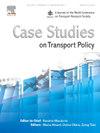An assessment of the potential contribution of overnight trains to sustainable long distance travel in Europe
IF 3.3
Q3 TRANSPORTATION
引用次数: 0
Abstract
While there has been a recent resurgence in interest in overnight trains in Europe, associated with increased public concern regarding the environmental sustainability of long-distance travel, a systematic literature review revealed that there has been almost no published academic analysis of the extent to which this revival might contribute to transport decarbonisation. This paper helps to fill this gap by providing a high-level quantitative assessment of the extent to which overnight train services in Europe would need to be expanded in order for them to make a substantive contribution to transport decarbonisation. It describes the historical development of overnight trains in Europe, and reviews previous research on this relatively neglected transport mode. It then shows through an assessment of intra-European aviation traffic in 2022–23 that while approximately 35% of this traffic is on routes which could feasibly be served by overnight trains, several hundred additional overnight train services would be required to accommodate even 10% of current air passengers. On average only 3–4 daily return overnight train pairs per year have been added to the European network in recent years despite their supposed revival. Rolling stock availability is currently a key constraint on the expansion of overnight train provision. If overnight trains are to play a meaningful role in the decarbonisation of long distance transport, coordinated large-scale government investment in rolling stock could be necessary to facilitate a step change in service levels. Despite this, overnight trains may still provide the most viable option for providing low-carbon travel on many flows in Europe.
通宵列车对欧洲可持续长途旅行的潜在贡献评估
随着公众对长途旅行的环境可持续性的日益关注,欧洲最近对通宵火车的兴趣有所回升,但一项系统的文献综述显示,几乎没有发表过关于这种复兴在多大程度上有助于运输脱碳的学术分析。本文通过对欧洲夜间列车服务需要扩大的程度进行高水平的定量评估,以便为运输脱碳做出实质性贡献,从而帮助填补了这一空白。它描述了欧洲过夜火车的历史发展,并回顾了以往对这种相对被忽视的运输方式的研究。然后,通过对2022-23年欧洲内部航空交通的评估显示,虽然大约35%的交通是可以通过夜间列车服务的,但需要数百个额外的夜间列车服务来容纳10%的现有航空乘客。近年来,欧洲铁路网络平均每年只增加3-4对往返的夜间列车,尽管它们被认为正在复苏。目前,机车车辆供应是制约夜间列车供应扩大的一个关键因素。如果夜间列车要在长途运输的脱碳中发挥有意义的作用,可能需要政府对铁路车辆进行协调的大规模投资,以促进服务水平的逐步改变。尽管如此,夜间列车可能仍然是欧洲许多河流中提供低碳旅行的最可行选择。
本文章由计算机程序翻译,如有差异,请以英文原文为准。
求助全文
约1分钟内获得全文
求助全文

 求助内容:
求助内容: 应助结果提醒方式:
应助结果提醒方式:


